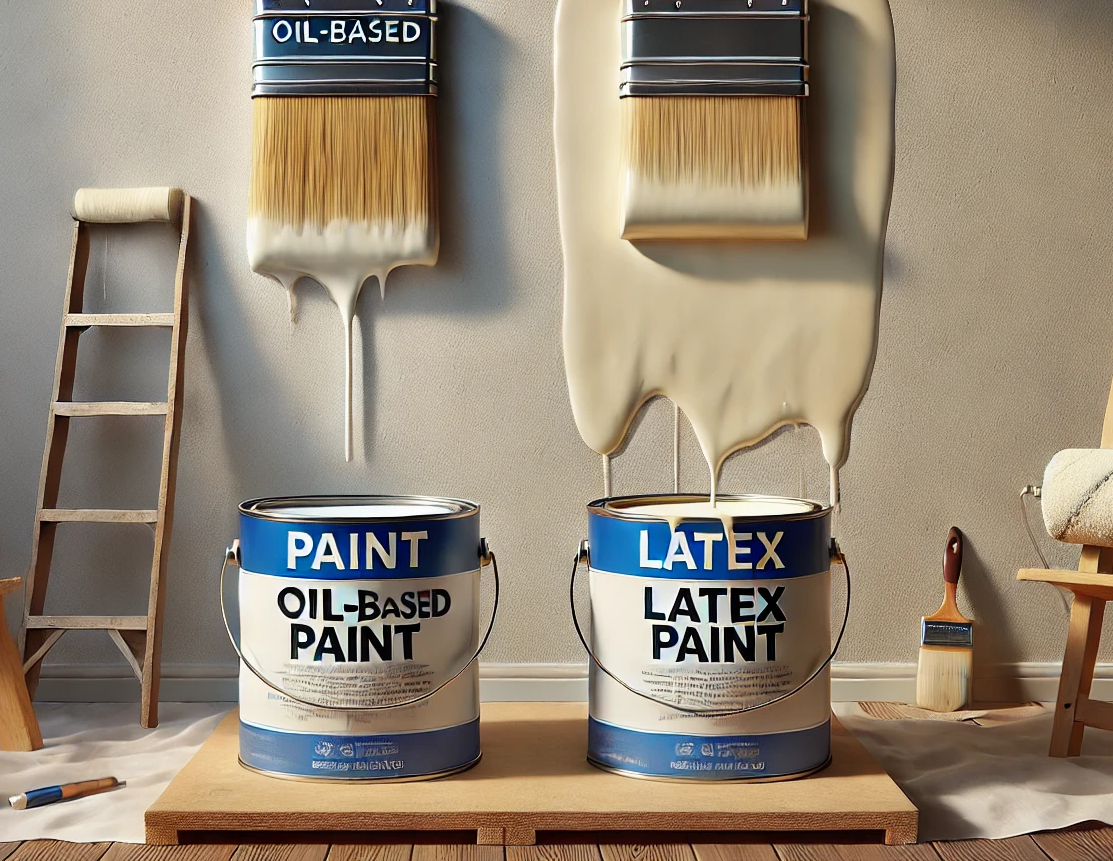What is the Difference Between Oil-Based and Latex Paint?

Key Highlights of the Article
- Understanding the composition and characteristics of oil-based and latex paints is crucial for choosing the right product.
- Oil-based paint offers durability and a rich finish, ideal for high-traffic areas and detailed work.
- Latex paint provides quick drying, low odor, and easy cleanup, making it perfect for walls and ceilings.
- Consider factors like surface type, location, and environmental impact when selecting paint for your project.
Introduction
When it comes to painting, choosing between oil-based and latex paints can be one of the most critical decisions you'll make for your project. Each type of paint has its own set of strengths and weaknesses, and selecting the right one can mean the difference between a job well done and a headache down the line. I remember a time when I was repainting the trim in my home—let’s just say the choice of paint made all the difference in how that project turned out.
Understanding Oil-Based Paint
Composition and Characteristics
Oil-based paint, also known as alkyd paint, is composed primarily of natural or synthetic oils and alkyd resins. This type of paint is known for its smooth, durable finish, making it a popular choice for high-traffic areas. The oil in the paint helps it flow and level out, reducing the appearance of brush strokes and creating a hard, glossy surface once dried. However, this also means that oil-based paints take longer to dry compared to their latex counterparts. If you’ve ever painted a door or trim with oil-based paint, you’ll know that patience is key—you’re looking at 24 hours or more before it’s fully dry to the touch.
Ideal Uses for Oil-Based Paint
Oil-based paint is best suited for areas where durability and a smooth finish are paramount. It’s the go-to choice for painting trim, doors, cabinets, and even furniture. These surfaces often require a tough, washable finish that can withstand bumps, scrapes, and frequent cleaning. I remember working on a client’s kitchen cabinets, and the oil-based paint not only provided a rich, lustrous finish but also held up beautifully against daily wear and tear. In high-traffic areas or surfaces exposed to a lot of handling, oil-based paint’s adhesion and hardness are unmatched.
Pros and Cons of Oil-Based Paint
Advantages:
- Durability: Oil-based paint forms a hard, resilient surface that can withstand more wear and tear than latex paint. This makes it ideal for high-traffic areas and surfaces that need to be cleaned often.
- Rich Finish: The finish of oil-based paint is typically glossier and more lustrous than latex, giving surfaces a high-end, polished look.
- Excellent Adhesion: Oil-based paint adheres well to most surfaces, including metals and previously painted surfaces, without the need for a primer in many cases.
Disadvantages:
- Longer Drying Time: One of the biggest drawbacks of oil-based paint is its extended drying time. If you’re working on a project where speed is a factor, waiting for oil-based paint to dry can be frustrating.
- Strong Odor and VOC Emissions: Oil-based paints emit strong fumes due to their high levels of volatile organic compounds (VOCs). Proper ventilation is a must, and these fumes can be harmful if not managed correctly.
- Clean-Up and Disposal: Cleaning up oil-based paint requires solvents like mineral spirits or turpentine, which can be messy and require careful handling. Additionally, disposing of leftover paint and used cleaning materials can be more complicated due to environmental regulations.

Exploring Latex Paint
When it comes to painting, latex paint is often the go-to choice for many homeowners and professionals alike. Its versatility and ease of use make it a popular option for a wide range of projects. Let’s dive into what makes latex paint such a reliable choice and where it really shines.
Composition and Characteristics
Latex paint, also known as water-based paint, is made primarily from water and acrylic resins. The key component here is the acrylic resin, which gives latex paint its flexibility and durability. Unlike oil-based paints, latex paints dry quickly because the water in the paint evaporates, leaving behind the color and protective film. This quick-drying feature is a significant advantage, especially when you're working on a tight schedule or need to apply multiple coats in a short period.
One of the most appreciated characteristics of latex paint is its ease of cleanup. Since it’s water-based, you can clean brushes, rollers, and even spills with just soap and water—no need for harsh chemicals like turpentine or mineral spirits. This makes latex paint not only user-friendly but also environmentally safer compared to oil-based options.
Latex paint is also known for its flexibility. This means it can expand and contract with the surface it's applied to, which is particularly useful in environments that experience temperature fluctuations. For example, I once worked on a project where the client’s home was exposed to a lot of sunlight and varying temperatures throughout the year. Latex paint was the perfect choice because it didn't crack or peel as the surface expanded and contracted.
Ideal Uses for Latex Paint
Latex paint is incredibly versatile and can be used on a variety of surfaces. It's the top choice for most interior and exterior painting projects. Here’s where it really excels:
- Walls and Ceilings: Latex paint is ideal for interior walls and ceilings because of its smooth finish and ease of application. Whether you’re refreshing your living room or giving your bedroom a new look, latex paint provides excellent coverage and color retention.
- Exterior Surfaces: Thanks to its weather-resistant properties, latex paint is also a great option for outdoor projects. It can withstand harsh weather conditions, from heavy rains to intense sunlight, without fading or peeling. I recall a project where we painted the exterior of a home that was constantly exposed to the elements. The latex paint held up beautifully, keeping the house looking fresh for years.
- Trim and Woodwork: While oil-based paint has traditionally been used for trim and woodwork, latex paint has improved significantly and can now be a viable option for these surfaces as well. It’s easier to apply, dries faster, and doesn’t yellow over time like oil-based paints can.
Pros and Cons of Latex Paint
Advantages:
- Fast Drying Time: One of the biggest advantages of latex paint is its quick drying time. This is especially useful when you need to finish a project quickly or apply multiple coats in a single day.
- Low Odor: Latex paint has a much lower odor than oil-based paint, making it more pleasant to work with, especially in enclosed spaces. This is a major plus for those sensitive to strong smells.
- Easy Cleanup: As mentioned earlier, cleaning up after using latex paint is a breeze. Just soap and water will do the trick, making post-painting cleanup less of a chore.
- Eco-Friendly: Latex paint is generally more environmentally friendly than oil-based paints. It has lower VOC (volatile organic compound) levels, which means fewer harmful emissions during and after application.
Disadvantages:
- Less Durability in High-Traffic Areas: While latex paint is durable, it doesn’t match the toughness of oil-based paints in high-traffic areas like hallways, trim, or doors. It’s more prone to chipping and scuffing, so it might not be the best choice for areas that see a lot of wear and tear.
- May Require More Coats: In some cases, latex paint might require more coats to achieve the desired opacity, especially when covering darker colors. This can extend the time needed to complete a project and increase the amount of paint used.
- Not Ideal for All Surfaces: Latex paint isn’t always the best choice for certain surfaces, like metal or glossy finishes, where oil-based paints might provide better adhesion and durability.
In Our Experience:
"We've learned that the choice between oil-based and latex paints can significantly impact the outcome of a painting project. For instance, in a recent kitchen remodel, we opted for oil-based paint due to its superior durability and resistance to moisture, which was ideal for the high humidity environment. The result was a glossy, professional finish that the client loved. On another occasion, we used latex paint for a large-scale residential project involving several bedrooms. The quick-dry formula allowed us to deliver a clean, odor-free environment, greatly enhancing the client's satisfaction. Our hands-on experiences underscore the importance of selecting the right paint type based on the specific requirements and conditions of each project."
Comparing Oil-Based and Latex Paint
When it comes to choosing between oil-based and latex paint, understanding the differences in durability, application, and environmental impact is key to making the right decision for your project. Both types of paint have their strengths and weaknesses, and the best choice often depends on the specific needs of your project.
Durability and Longevity
Oil-Based Paint:
Oil-based paints are known for their exceptional durability and longevity. They form a hard, protective shell that can withstand wear and tear, making them ideal for high-traffic areas like trim, doors, and cabinets. I remember a project where we used oil-based paint on a historic home’s exterior. Years later, the finish still looked as fresh as the day it was applied, despite the harsh weather conditions it had endured.
The downside of oil-based paint is that it tends to yellow over time, especially in areas that don’t receive much sunlight. This can be a drawback for interiors where maintaining a bright, true color is important.
Latex Paint:
Latex paint, on the other hand, offers great durability but doesn’t quite match the toughness of oil-based paint in high-traffic or exterior applications. However, advances in technology have made latex paint much more durable than it used to be. It’s flexible, meaning it can expand and contract with temperature changes without cracking, which is particularly beneficial for exterior surfaces.
In my experience, latex paint holds up well on interior walls, ceilings, and exterior surfaces that aren’t subject to extreme conditions. It’s also less prone to yellowing, so your colors stay true over time. If you’re looking for a paint that will maintain its appearance for years without significant fading or discoloration, latex is often the better choice.
Ease of Application
Oil-Based Paint:
Applying oil-based paint requires a bit more skill and preparation. It typically needs to be applied with a natural-bristle brush or a high-quality roller to achieve a smooth finish. It also takes longer to dry, which can be a double-edged sword. On one hand, the longer drying time gives you more working time to correct any mistakes, but on the other hand, it extends the project timeline.
One of the challenges I’ve encountered with oil-based paint is the need for thorough surface preparation. Any grease, dirt, or previous coatings must be meticulously cleaned or sanded away, as oil-based paint won’t adhere well to an unprepared surface.
Latex Paint:
Latex paint is much easier to work with, especially for DIY enthusiasts. It’s compatible with synthetic brushes and rollers, which are widely available and easy to clean with just soap and water. Latex paint dries quickly, usually within a few hours, allowing you to apply multiple coats in a single day and finish your project faster.
I’ve often recommended latex paint to clients who are new to painting or working on a tight schedule. Its forgiving nature and ease of cleanup make it the go-to option for most interior projects. Plus, if you make a mistake, it’s easier to correct with additional coats since latex paint layers smoothly.
Environmental Impact
Oil-Based Paint:
One of the significant drawbacks of oil-based paint is its environmental impact. It contains higher levels of volatile organic compounds (VOCs), which are harmful to both the environment and indoor air quality. The strong fumes emitted during application require good ventilation, and improper disposal of oil-based paints and solvents can lead to environmental contamination.In a world where sustainability is becoming increasingly important, oil-based paint’s environmental footprint can’t be ignored. It’s something I always discuss with clients who are concerned about eco-friendliness.
Latex Paint:
Latex paint is the greener option between the two. It has lower VOC levels, making it a healthier choice for both the painter and the occupants of the space. Latex paints are water-based, so they emit fewer toxic fumes and are easier to dispose of safely. This makes latex paint not only better for the environment but also safer for indoor use, particularly in homes with children or pets.

Choosing the Right Paint for Your Project
When it comes to painting projects, one of the most critical decisions you'll make is choosing the right type of paint. Whether you're refreshing a single room or tackling a large-scale renovation, selecting the appropriate paint can make all the difference in achieving a durable, beautiful finish. As a veteran in the painting industry, I've seen firsthand how the right choice can transform a space—and how the wrong one can lead to unnecessary headaches. Let’s dive into the key factors to consider when choosing between oil-based and latex paints, along with some professional recommendations to help guide your decision.
Factors to Consider
Surface Type: The surface you're painting plays a significant role in determining the best paint type. Oil-based paints are often the go-to for woodwork, trim, and high-traffic areas because of their durability and smooth finish. I recall a project where we were restoring an old Victorian home with intricate wooden trim. The oil-based paint provided the perfect, glossy finish that accentuated the details and withstood the wear and tear that comes with time.
Latex paint, on the other hand, is ideal for walls, ceilings, and exterior surfaces. Its flexibility allows it to expand and contract with temperature changes, reducing the risk of cracking or peeling. I’ve used latex paint on many exterior projects where its quick drying time and resistance to the elements were invaluable.
Location: The location of the surface, whether it’s indoors or outdoors, also affects your choice. Oil-based paints are excellent for outdoor surfaces where weather resistance is paramount. They form a hard shell that can endure rain, sun, and fluctuating temperatures. However, for interior spaces, especially those that are frequently occupied, latex paint is often preferred due to its lower odor and quicker drying time, making it more convenient and less disruptive to daily life.
Desired Finish: The finish you’re aiming for—whether it’s matte, satin, semi-gloss, or high-gloss—can influence your paint choice. Oil-based paints are typically associated with a richer, more polished finish, making them ideal for areas where you want to highlight architectural details. Latex paints, however, offer a variety of finishes that can suit different aesthetic preferences, from the subtlety of a matte finish to the sleekness of a semi-gloss.
Durability Needs: Consider the wear and tear the painted surface will endure. Oil-based paints are known for their toughness and are great for surfaces that need to withstand frequent cleaning, like kitchen cabinets or bathroom vanities. Latex paints are also durable but may require more frequent touch-ups in high-traffic areas.
Cost Considerations
Initial Cost vs. Long-Term Value: When comparing oil-based and latex paints, it’s essential to weigh the initial cost against the long-term value. Oil-based paints tend to be more expensive upfront, but their durability often means you won’t need to repaint as frequently. This can be a significant saving over time, especially in high-traffic or exposed areas. On the other hand, latex paint is generally more affordable and easier to apply, making it a budget-friendly option for most interior projects.
Budget-Friendly Tips: If you’re working within a tight budget, consider using latex paint for larger, less demanding areas like walls and ceilings while reserving oil-based paint for trim and high-impact areas. This approach allows you to maximize durability where it’s needed most while keeping overall costs in check.
Lightmen Painting’s Recommendations
Professional Advice: At Lightmen Painting, we often recommend latex paint for most interior applications due to its ease of use, quick drying time, and low odor—qualities that are particularly important in occupied spaces. For exterior projects, or areas where durability is crucial, such as doors and trim, oil-based paint is our preferred choice.
Project Examples: One project that comes to mind is a historic home where we used oil-based paint on the front door and trim to enhance the home’s curb appeal and protect it from the elements. For the interior walls, we opted for latex paint, which provided a beautiful finish and allowed the homeowners to move back in quickly without the lingering odor typical of oil-based paints.
Conclusion
Choosing the right paint—whether oil-based or latex—can significantly impact the success of your project. While oil-based paints offer unparalleled durability and a lustrous finish, latex paints provide flexibility, ease of use, and environmental benefits. When making your decision, consider the surface type, location, desired finish, and long-term durability needs.
At Lightmen Painting, we understand that every project is unique, and selecting the right paint is just one part of the equation. We’re here to provide expert advice and ensure that your next painting project not only looks fantastic but also stands the test of time. Whether you're leaning toward oil-based paint for its durability or latex paint for its versatility, our team is ready to help you achieve the best possible results.
Call to Action: If you’re still unsure which paint is right for your project, don’t hesitate to contact Lightmen Painting. Our team of professionals is here to provide guidance and ensure a flawless finish every time.
Do You Have Questions? Give Us A Call With Any & All! 503-389-5758
-
People Also Ask:
What are the main differences between oil-based and latex paints?
Oil-based paints are known for their durability and smooth finish, making them ideal for trim work and surfaces that require frequent cleaning. They tend to have a longer drying time and emit strong odors due to high VOC levels. Latex paints, on the other hand, are water-based, which means they dry quickly, emit less odor, and are easier to clean up with just soap and water. They are flexible and less prone to cracking, making them suitable for walls and ceilings.
Which paint type should I use for high-traffic areas?
For high-traffic areas, oil-based paint is often recommended due to its durability and resistance to wear and tear. Its tougher finish makes it ideal for surfaces like doors, cabinets, and trim work that may require more frequent cleaning. However, advancements in latex paint formulations have improved their durability, making them increasingly popular for busy areas as well.
Are there environmental considerations when choosing between oil-based and latex paints?
Yes, environmental considerations play a significant role in choosing between oil-based and latex paints. Oil-based paints contain higher levels of volatile organic compounds (VOCs), which can contribute to indoor air pollution and pose health risks. Latex paints generally have lower VOC levels, making them a more environmentally friendly option. Choosing paints with lower VOC content is better for both indoor air quality and the environment.
-
SUBSCRIBE TO OUR BLOG: Stay informed with the latest in Painting and DIY projects by subscribing to Lightmen Painting. Get insights, tips, and more delivered straight to your inbox. We would also love to know what you would like to read about, leave thoughts on where we should go next. Interests, Topics, Ideas, all are welcome.
Get $3000 in assistant credits from Magic
^ Click Our Logo Above ^
If your in the Portland, Or. area and need advice or a free no obligation estimate call us at 503-389-5758 or email scheduling@lightmenpainting.com
Shout Out:
Celebrating GardenSmart: Your Source for Horticultural Excellence
From the team at Lightmen Painting, we extend our highest praise to GardenSmart for their dedication to promoting horticultural education and inspiration. Just as we strive for excellence and meticulous craftsmanship in our painting services, GardenSmart excels in providing valuable resources and informative programs that help gardeners of all levels enhance their skills and cultivate beautiful landscapes. Their commitment to quality and community engagement aligns perfectly with our mission to enhance and beautify environments.
Thanks for stopping by Lightmen Daily! Stay tuned for more practical tips and expert advice on making your painting projects flawless, from wall to floor!
Definitions
- Acrylic Resins: Used in latex paints, these resins offer flexibility and color retention, aiding in the paint's overall durability and aesthetic qualities.
- VOC Emissions: Volatile Organic Compounds emitted by various paints, with oil-based variants typically releasing higher levels.
- Microbial Resistance: The ability of paint to resist mold and mildew, often stronger in oil-based paints.
- Latex Paint: Water-based paint known for its quick drying, ease of cleanup, and environmental friendliness.
- Oil-Based Paint: Paint that uses a petroleum-based solvent, noted for its durability and glossy finish.
- Surface Preparation: The process of cleaning, sanding, and priming a surface before applying paint to ensure optimal adherence and finish.
- Trenchless Technology: Methods used in construction to install or repair pipelines underground without extensive excavation.
- Horizontal Directional Drilling: A trenchless method used for installing underground pipes that minimizes surface disturbance.
- Eco-Friendly Options: Paint products designed to minimize environmental impact, including those with low VOC levels.
Lightmen Painting Serving: Portland, Tigard, Lake Oswego, Tualatin, West Linn, Milwaukie, Sherwood, Happy Valley, Oregon City, Beaverton, Hillsboro, Gresham -Trade Partners-

